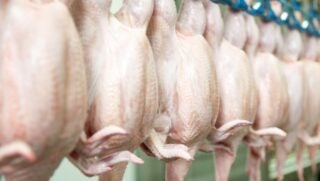Recently my friend tagged me in this tweet claiming to be about poultry processed for Chick-fil-A’s fast-food chain:
This is where your Chic-fil-A comes from. https://t.co/nRKF1vi6Ir pic.twitter.com/fpLk0RA2YU
— Leighton Woodhouse (@lwoodhouse) September 29, 2021
Up front, so we know who we’re dealing with, an online search of his name shows that the author of the tweet is a Los Angeles-based vegan animal-rights activist — one who has extensively published articles against meat consumption (it’s probably safe to straight-up call them hit pieces).
But let’s talk about the approach we see in the tweet, shall we?
It’s the same recycled tactic from these extremist groups. It’s not unusual for them to create scary posts that can be easily misunderstood and say, “This is where your bacon comes from,” or, “This is where your Chick-fil-A meal comes from” … but is it really?
The article from the original tweet cites the usual suspects: Direct Action Everywhere (DxE) and Mercy for Animals. DxE is notoriously known for breaking the law and going to extremes with the founder himself having more than a dozen felony charges, plus several misdemeanors, under his belt. In addition, DxE has been trespassing and harassing Foster Farms plants and posting about it on social media, claiming they’re “rescuing” (also known as stealing) livestock from processing facilities.
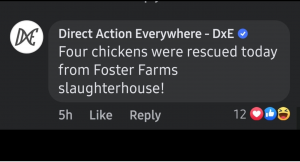
Look, I’ve lived, worked, and toured livestock farms and animal research facilities as my career for years. And the more I learn, the more impressed I become. Do I have a bias towards eating meat? Sure. Do I want to promote farmers for a living? Absolutely.
However, if there’s any truth to claims that animals are genuinely mistreated and I can prove it with my own two eyes while investigating all sides of a story, I want to challenge my biases, change my mind, and be the first to expose any breaking of the law within ag and absolutely put a stop to it. However, when an article comes from activist groups that are only loosely connected to farming and ranching, always raise a skeptical eyebrow.
I try to dig in and find any truth to their claims — but what they say always seems to fall short in terms of reality and factuality.
In this instance, I messaged Leighton Woodhouse and asked for evidence of his claim. And this was that conversation:
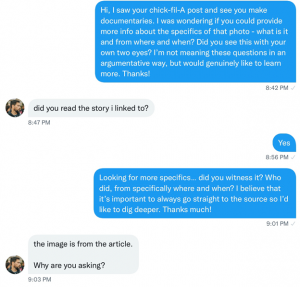
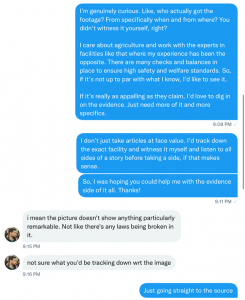

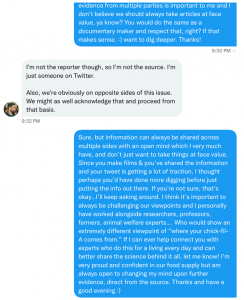
It should be a rational discussion. But if you put the information out there — that “This is where your Chick-fil-A comes from” — you should be prepared to back it up. Like, which facility? From where and when? Crickets from this activist.
In my own online exploration, the image appears to come from a nearly 8-minute DxE video posted to YouTube late in September. The title card claims it’s from a Foster Farms high-speed processing facility in Livingston, California. But because it was posted by DxE, the claims should be challenged and examined more deeply, as with any agenda-based outfit.
Animal-rights activists oftentimes perform criminal, illegal stunts, hyperbole, and misinformation for their agenda to solicit donations and try to get people to give up meat. Videos are often staged, recycled, outdated, or may even be from another country. And I’m sure they’ll probably attack me for even posting this — something that would challenge their views on the real science-based truth on animal agriculture — that it’s full of boring rules and regulations.
The moral of the story? Don’t be intellectually lazy. Extraordinary claims require extraordinary evidence. Always examine the evidence, and don’t believe everything you see or read.
More here on the science of poultry care and here on the truth of animal rights activist videos. Until there is actual credible evidence to the negative claims put forth toward Foster Farms or Chick-Fil-A, I think it’s safe to assume that this is just another publicity stunt on the end of vegan activists and business as usual with food safety and processing which is highly regulated and safe.
Michelle Miller, the Farm Babe, is a farmer, public speaker and writer who has worked for years with row crops, beef cattle, and sheep. She believes education is key in bridging the gap between farmers and consumers.


